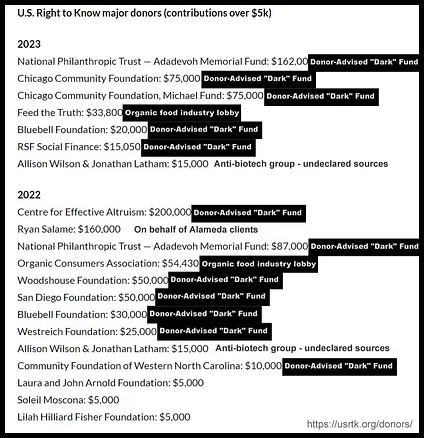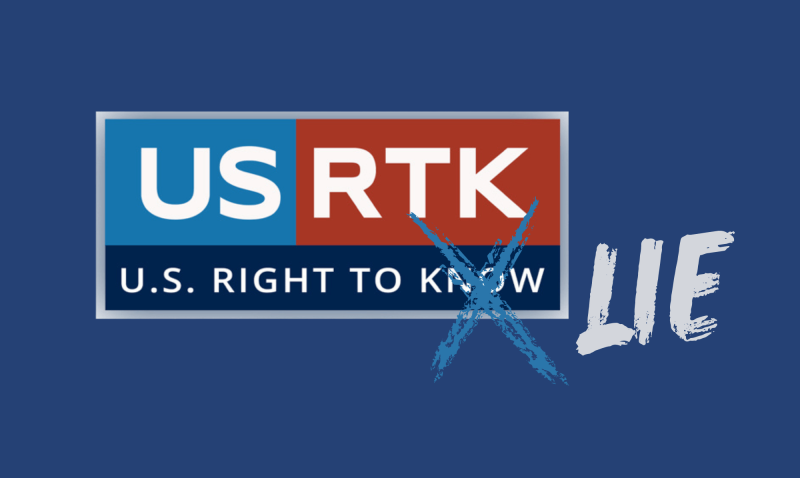Donor-advised funds allow activist groups to receive unlimited donations from undisclosed sources. This is important in cases where an NGO, activist, researcher or tort law firm is acting on behalf of the interests of the funders (ie, shilling) and where disclosure of the source might discredit the campaign outcome or reveal a conflict of interest. It allows the NGOs to more easily deceive their public.
This non-disclosure is a sacred part of the donor-advised money mill. If a donor with an interest has no problem having the donation made public, then the funds would be given directly to the recipient rather than paying fees to have the financial source “purified”. It is essentially dark money but unlike mob money in brown envelopes, it is tax deductible. Donor-advised funds are not at all transparent, deceptive and, I would argue, unethical. Since it hides sources of influence, it should be illegal.
In the case of the NGO, US Right to Know, we can also add: hypocritical.
US Right to Dark Money
The US Right to Know NGO grew out of the failed 2014 Just Label It campaign that demanded transparency and openness on GMOs. They campaign for the right to know who is funding research, organizations and lobbying campaigns and spend their research budget trying to expose companies and industry group activities. Their key objective is to destroy corporations, so they have worked intensely with a large number of US tort law firms, especially around the glyphosate lawsuits and the diffusion of the Monsanto Papers.
As they run anti-capitalist, anti-industry campaigns on behalf of their funders, US Right to Know have mostly focused on exposing pesticides, chemicals, food and pharmaceutical industries. They did try to be transparent on their funding at first but received a lot of criticism as most of their funds came from the organic food industry lobby and some anti-vaccine foundations. Now they are pretending to publish their revenue sources, but almost all of it is dark, donor-advised fund money.
In other words, we really don’t know who is now funding this pack of wolves and can only guess according to the campaigns US Right to Know are hired to run. I suspect a lot of money comes from the equally opaque tort law industry, not only in return for the relentless, pro bono support Carey Gillam gave on the glyphosate-Monsanto trials but also for running the recent public outrage grooming campaigns against Coke in the wake of the IARC aspartame cancer study publication.
Could Gary and Stacy be getting Russian money? Who knows. They used to be regulars on Russia Today.
The graphic below shows how dark and cloudy the US Right to Know’s funding has become over the last two years. As they do not have to declare who their actual sources are, it is left to the imagination which interest groups want this “pay-to-slay” NGO to act on their behalf. The one takehome though is that the next time these self-righteous activists cry about undisclosed corporate funding, the word “hypocrite” should be uttered.

If we look at the trends over the last five years, the NGO’s fundraising shifted from mostly public to almost all dark, donor-advised funds. This reflects a general trend in foundation giving and the end of NGOs claiming to operate transparently. Some of their funding though is quite unusual or downright bizarre. For example:
- The largest funder this year, the Adadevoh Memorial Fund, is a Nigerian fund named after a heroic doctor who died from Ebola. Why would a Nigerian healthcare foundation be donating to a left-wing American political activist group?
- The Centre for Effective Altruism is a controversial donor-advised fund aimed at making young billionaires feel less bad about how they acquired their wealth. As the $200K donated to US Right to Know in 2022 was a one-off along with FTX’s Ryan Salame’s $160K, we can only assume that this is Sam Bankman-Fried cash via the Alameda hedge fund (see image below). SBF spoke glowingly about effective altruism and seemed OK to steal from his hedge fund clients to donate more. (As this is stolen money, if US Right to Know had any integrity, they should give it back to the cheated investors.)
- Allison Wilson and Jonathan Latham are anti-biotech campaigners who have never disclosed the sources of their funding.
- Three donor-advised funds: Chicago Community Foundation ($150K), San Diego Foundation ($50K) and Community Foundation of Western North Carolina ($10K) are all committed to alleviating poverty and addressing need in their local communities. UK Right to Know does not do this type of work so we can assume they flipped some donors already involved in their communities and decided to leave their donations dark.
So where did the organic food lobby and anti-vax money go in 2023? Given events, the money surely did not run out, but with all of their donor-advised funds, I’m afraid the rest of us have been left in the dark.
We do not have a right to know and now it’s none of your damn business.

David Zaruk is the Firebreak editor, and also writes under the pen-name The Risk Monger. David is a retired professor, environmental-health risk analyst, science communicator, promoter of evidence-based policy and philosophical theorist on activists and the media. Find David on X @Zaruk
A version of this article was originally posted at Firebreak and has been reposted here with permission. Any reposting should credit the original author and provide links to both the GLP and the original article. Find Firebreak on X @the_firebreak































